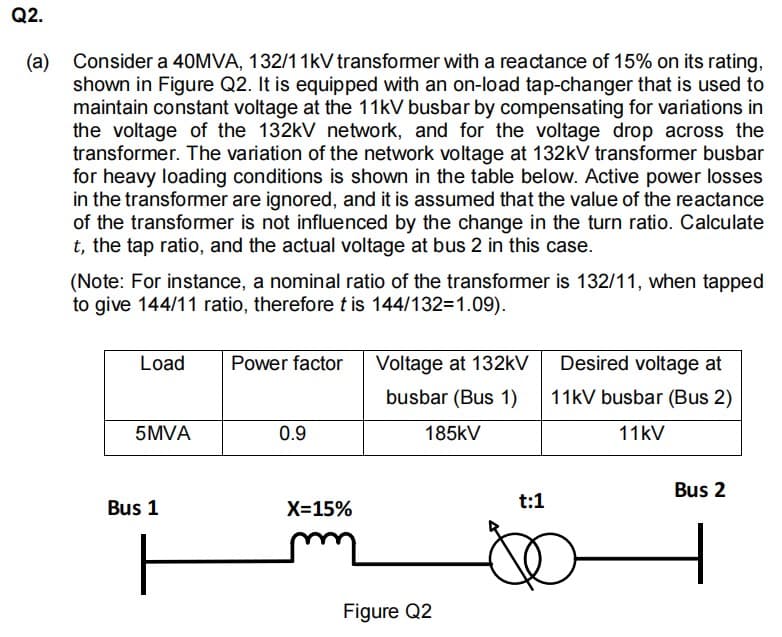Q2. Consider a 40MVA, 132/11kV transformer with a reactance of 15% on its rating, (a) shown in Figure Q2. It is equipped with an on-load tap-changer that is used to maintain constant voltage at the 11kV busbar by compensating for variations in the voltage of the 132kV network, and for the voltage drop across the transformer. The variation of the network voltage at 132KV transformer busbar for heavy loading conditions is shown in the table below. Active power losses in the transformer are ignored, and it is assumed that the value of the reactance of the transformer is not influenced by the change in the turn ratio. Calculate t, the tap ratio, and the actual voltage at bus 2 in this case. (Note: For instance, a nominal ratio of the transformer is 132/11, when tapped to give 144/11 ratio, therefore t is 144/132=1.09). Load Power factor Voltage at 132kV Desired voltage at busbar (Bus 1) 11kV busbar (Bus 2) 5MVA 0.9 185kV 11kV Bus 2 Bus 1 X=15% t:1 Figure Q2
Q2. Consider a 40MVA, 132/11kV transformer with a reactance of 15% on its rating, (a) shown in Figure Q2. It is equipped with an on-load tap-changer that is used to maintain constant voltage at the 11kV busbar by compensating for variations in the voltage of the 132kV network, and for the voltage drop across the transformer. The variation of the network voltage at 132KV transformer busbar for heavy loading conditions is shown in the table below. Active power losses in the transformer are ignored, and it is assumed that the value of the reactance of the transformer is not influenced by the change in the turn ratio. Calculate t, the tap ratio, and the actual voltage at bus 2 in this case. (Note: For instance, a nominal ratio of the transformer is 132/11, when tapped to give 144/11 ratio, therefore t is 144/132=1.09). Load Power factor Voltage at 132kV Desired voltage at busbar (Bus 1) 11kV busbar (Bus 2) 5MVA 0.9 185kV 11kV Bus 2 Bus 1 X=15% t:1 Figure Q2
Power System Analysis and Design (MindTap Course List)
6th Edition
ISBN:9781305632134
Author:J. Duncan Glover, Thomas Overbye, Mulukutla S. Sarma
Publisher:J. Duncan Glover, Thomas Overbye, Mulukutla S. Sarma
Chapter3: Power Transformers
Section: Chapter Questions
Problem 3.17P: The transformer of Problem 3.16 is supplying a rated load of 50 kVA at a rated secondary voltage of...
Related questions
Question
2a

Transcribed Image Text:Q2.
(a) Consider a 40MVA, 132/11kV transformer with a reactance of 15% on its rating,
shown in Figure Q2. It is equipped with an on-load tap-changer that is used to
maintain constant voltage at the 11kV busbar by compensating for variations in
the voltage of the 132kV network, and for the voltage drop across the
transformer. The variation of the network voltage at 132kV transformer busbar
for heavy loading conditions is shown in the table below. Active power losses
in the transformer are ignored, and it is assumed that the value of the reactance
of the transformer is not influenced by the change in the turn ratio. Calculate
t, the tap ratio, and the actual voltage at bus 2 in this case.
(Note: For instance, a nominal ratio of the transformer is 132/11, when tapped
to give 144/11 ratio, therefore t is 144/132=1.09).
Load
Power factor
Voltage at 132kV
Desired voltage at
busbar (Bus 1)
11kV busbar (Bus 2)
5MVA
0.9
185kV
11kV
Bus 2
Bus 1
X-15%
t:1
Figure Q2
Expert Solution
This question has been solved!
Explore an expertly crafted, step-by-step solution for a thorough understanding of key concepts.
Step by step
Solved in 2 steps with 2 images

Knowledge Booster
Learn more about
Need a deep-dive on the concept behind this application? Look no further. Learn more about this topic, electrical-engineering and related others by exploring similar questions and additional content below.Recommended textbooks for you

Power System Analysis and Design (MindTap Course …
Electrical Engineering
ISBN:
9781305632134
Author:
J. Duncan Glover, Thomas Overbye, Mulukutla S. Sarma
Publisher:
Cengage Learning

Power System Analysis and Design (MindTap Course …
Electrical Engineering
ISBN:
9781305632134
Author:
J. Duncan Glover, Thomas Overbye, Mulukutla S. Sarma
Publisher:
Cengage Learning